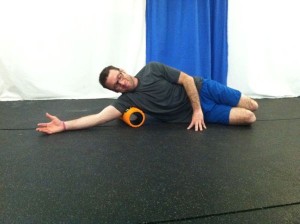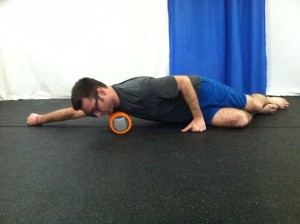This is the final installment of my series on Posture. A few weeks ago, I describedposture as the absolute need for stability.
“It is from stability that all healthy movement is derived.”
I keyed in on thefeet as the foundationand thehips as the ballast of the body. Today I will discuss the body's most mobile joint: the shoulder, and more specifically: the scapula – otherwise called the shoulder blade. The scapula is the mast and sails of the body. Where the scapula goes, the head and torso will follow.
[video=youtube_share;e-1dOuIUi9s]http://www.youtube.com/watch?v=e-1dOuIUi9s&feature=player_embedded[/video]
As I said a few weeks ago, “stability is king.” When it comes to the shoulder the scapula is the King of stability. The scapula is the anchoring point for the postural muscles of the shoulder; it provides the stability necessary for a huge combination of movements. This large range of motion is something that distinguishes us from all other species on the planet. The shoulder is designed to provide for the movements of climbing, crawling, lifting, throwing, pushing, and pulling; and aids in the movements of running and jumping. None of these movements would be possible without the scapula's amazing ability to stabilize.
At home and in the workplace we do not regularly engage our shoulders to meet their designed movement patterns, and what you don't use, you lose. Instead we sit for 8-12 hours each day in front of a computer, TV or in our cars – and most of us sit with our head and shoulders forward. This posture pulls the scapula out of a position of leverage, where it is capable of providing the greatest amount of stabilization to the body. Over time, the postural muscles that are responsible for scapular stability are shut off (just like the postural muscles of the lower core and hips that I addressed inWhat is PostureandThe Hips). Once thepostural[/b]muscles are shut off, the body must recruitstability[/b]frommobility muscles[/b]such as the biceps, pecs, and trapezius. As these muscles take over, they lock the scapula in an upward rotation, and prevent the body from packing them down where they function most effectively. When the scapula are stuck in upward rotation, they lose their functional range of motion and true stabilization of the shoulder becomes difficult. And remember, where your scapula goes, your head will follow. Once the stability of the scapula is lost, the shoulder, neck, and lower back are put in a position of stress with a greater risk ofpain and injury.
Keys to Regaining Shoulder Function[/b]
Scapular stability is vital to reducing pain, preventing injury, and improving your overall postural health. Here are the keys to regaining scapular stability and function:
The first and most important step to increasing the functional range of motion of the shoulder joint is throughmyofascial massage therapy. Anddeep tissue massage therapy(such asmyofascial releaseandself-myofascial release), when paired withfoam roller therapy, will help break downrestrictions in the fascial tissue. These often overlooked steps will improve tissue health,reduce chronic pain, increase functional joint range of motion, and prevent injury.
Immediately following a series of deep tissue massage treatments with a full body flexibility or stretching program will help to permanently establish the newly regained range of motion.Yoga,Pilates,EgoscueandActive Release Techniqueare just a few examples of effective flexibility programs you can try. I highly recommend hiring an experienced and qualified coach or therapist to ensure proper form and the best approach to a flexibility program that will meet your individual needs.
As range of motion improves, the next step is corrective exercise. The goal of corrective exercise for the shoulder is to train the shoulder's postural muscles to maintain proper position and stability and, as demonstrated in the video above, the ability to pack the scapula down.
Once the three pieces of the postural puzzle (the feet, hips and shoulders) are trained to, once again, provide stability, your body is ready to integrate functional movement training. These are exciting, challenging and often butt whipping workouts (which I love), and they will be the topics of discussion over the next few weeks.Self Myofascial Release Shoulder Exercises[/b]Here are a few self-massage exercises for opening up the shoulders. Find a painful spot, stop and visualize the soft tissue as melting butter and the foam roller as a hot knife. Allow pressure into the tissue and within 30-60 seconds you will notice a significant reduction in pain. Once the pain reduces significantly (20-30%), move on to the next painful spot and repeat.
Spend between 3-5 minutes on each side. It is very important that you spend an equal amount of time on both sides and that you work through each of the areas listed to gain the most out of self-myofascial release.

Lie on your side, your arm overhead and foam roller beneath your lats. Massage from the top of the arm to below the shoulder blade. Do not massage in the arm pit area.

Lie on your side, your arm overhead and foam roller beneath the chest. Do not massage in the arm pit area.

Lie on your side, your arm overhead and foam roller beneath the bicep. Do not massage in the arm pit area.
Corrective Exercises for the Shoulder[/b]
The following exercises will help regain functional range of motion of the scapula and shoulder.
Scapular Squeeze on Foam Roller[/b][/b]
[video=youtube_share;QDyWyH86h64]http://www.youtube.com/watch?v=QDyWyH86h64&feature=player_embedded[/video]
Press and squeeze the scapula around the foam roller then reach and extend toward the ceiling. Repeat 20 times.
Reverse Fly on Foam Roller[/b]
[video=youtube_share;6CHBOSPy98E]http://www.youtube.com/watch?v=6CHBOSPy98E&feature=player_embedded[/video]
Squeeze the scapula around the foam roller as you slowly drop your arms down. Continue to squeeze scapula into the foam roller as you return your arms to the starting position. Repeat 20 times.
Scapular Pushups[/b]
[video=youtube_share;m3SQyKiXVuo]http://www.youtube.com/watch?v=m3SQyKiXVuo&feature=player_embedded[/video]
Get in push-up or plank position (on feet or knees depending on ability level) with your hands directly beneath your chest. Make sure your body is in alignment with your hips level to your shoulders. Without bending your elbows and maintaining plank position, squeeze your shoulder blades together and press back out. Focus on squeezing together at the base of your scapula and not shrugging at your ears.
“It is from stability that all healthy movement is derived.”
I keyed in on thefeet as the foundationand thehips as the ballast of the body. Today I will discuss the body's most mobile joint: the shoulder, and more specifically: the scapula – otherwise called the shoulder blade. The scapula is the mast and sails of the body. Where the scapula goes, the head and torso will follow.
[video=youtube_share;e-1dOuIUi9s]http://www.youtube.com/watch?v=e-1dOuIUi9s&feature=player_embedded[/video]
As I said a few weeks ago, “stability is king.” When it comes to the shoulder the scapula is the King of stability. The scapula is the anchoring point for the postural muscles of the shoulder; it provides the stability necessary for a huge combination of movements. This large range of motion is something that distinguishes us from all other species on the planet. The shoulder is designed to provide for the movements of climbing, crawling, lifting, throwing, pushing, and pulling; and aids in the movements of running and jumping. None of these movements would be possible without the scapula's amazing ability to stabilize.
At home and in the workplace we do not regularly engage our shoulders to meet their designed movement patterns, and what you don't use, you lose. Instead we sit for 8-12 hours each day in front of a computer, TV or in our cars – and most of us sit with our head and shoulders forward. This posture pulls the scapula out of a position of leverage, where it is capable of providing the greatest amount of stabilization to the body. Over time, the postural muscles that are responsible for scapular stability are shut off (just like the postural muscles of the lower core and hips that I addressed inWhat is PostureandThe Hips). Once thepostural[/b]muscles are shut off, the body must recruitstability[/b]frommobility muscles[/b]such as the biceps, pecs, and trapezius. As these muscles take over, they lock the scapula in an upward rotation, and prevent the body from packing them down where they function most effectively. When the scapula are stuck in upward rotation, they lose their functional range of motion and true stabilization of the shoulder becomes difficult. And remember, where your scapula goes, your head will follow. Once the stability of the scapula is lost, the shoulder, neck, and lower back are put in a position of stress with a greater risk ofpain and injury.
Keys to Regaining Shoulder Function[/b]
Scapular stability is vital to reducing pain, preventing injury, and improving your overall postural health. Here are the keys to regaining scapular stability and function:
The first and most important step to increasing the functional range of motion of the shoulder joint is throughmyofascial massage therapy. Anddeep tissue massage therapy(such asmyofascial releaseandself-myofascial release), when paired withfoam roller therapy, will help break downrestrictions in the fascial tissue. These often overlooked steps will improve tissue health,reduce chronic pain, increase functional joint range of motion, and prevent injury.
Immediately following a series of deep tissue massage treatments with a full body flexibility or stretching program will help to permanently establish the newly regained range of motion.Yoga,Pilates,EgoscueandActive Release Techniqueare just a few examples of effective flexibility programs you can try. I highly recommend hiring an experienced and qualified coach or therapist to ensure proper form and the best approach to a flexibility program that will meet your individual needs.
As range of motion improves, the next step is corrective exercise. The goal of corrective exercise for the shoulder is to train the shoulder's postural muscles to maintain proper position and stability and, as demonstrated in the video above, the ability to pack the scapula down.
Once the three pieces of the postural puzzle (the feet, hips and shoulders) are trained to, once again, provide stability, your body is ready to integrate functional movement training. These are exciting, challenging and often butt whipping workouts (which I love), and they will be the topics of discussion over the next few weeks.Self Myofascial Release Shoulder Exercises[/b]Here are a few self-massage exercises for opening up the shoulders. Find a painful spot, stop and visualize the soft tissue as melting butter and the foam roller as a hot knife. Allow pressure into the tissue and within 30-60 seconds you will notice a significant reduction in pain. Once the pain reduces significantly (20-30%), move on to the next painful spot and repeat.
Spend between 3-5 minutes on each side. It is very important that you spend an equal amount of time on both sides and that you work through each of the areas listed to gain the most out of self-myofascial release.

Lie on your side, your arm overhead and foam roller beneath your lats. Massage from the top of the arm to below the shoulder blade. Do not massage in the arm pit area.

Lie on your side, your arm overhead and foam roller beneath the chest. Do not massage in the arm pit area.

Lie on your side, your arm overhead and foam roller beneath the bicep. Do not massage in the arm pit area.
Corrective Exercises for the Shoulder[/b]
The following exercises will help regain functional range of motion of the scapula and shoulder.
Scapular Squeeze on Foam Roller[/b][/b]
[video=youtube_share;QDyWyH86h64]http://www.youtube.com/watch?v=QDyWyH86h64&feature=player_embedded[/video]
Press and squeeze the scapula around the foam roller then reach and extend toward the ceiling. Repeat 20 times.
Reverse Fly on Foam Roller[/b]
[video=youtube_share;6CHBOSPy98E]http://www.youtube.com/watch?v=6CHBOSPy98E&feature=player_embedded[/video]
Squeeze the scapula around the foam roller as you slowly drop your arms down. Continue to squeeze scapula into the foam roller as you return your arms to the starting position. Repeat 20 times.
Scapular Pushups[/b]
[video=youtube_share;m3SQyKiXVuo]http://www.youtube.com/watch?v=m3SQyKiXVuo&feature=player_embedded[/video]
Get in push-up or plank position (on feet or knees depending on ability level) with your hands directly beneath your chest. Make sure your body is in alignment with your hips level to your shoulders. Without bending your elbows and maintaining plank position, squeeze your shoulder blades together and press back out. Focus on squeezing together at the base of your scapula and not shrugging at your ears.


